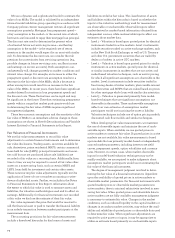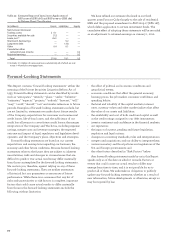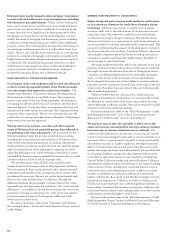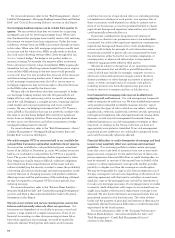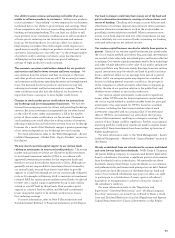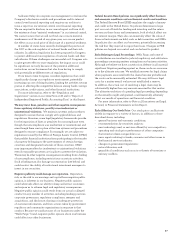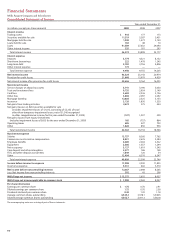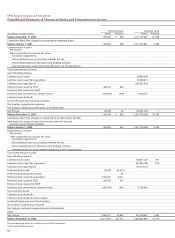Wells Fargo 2009 Annual Report Download - page 88
Download and view the complete annual report
Please find page 88 of the 2009 Wells Fargo annual report below. You can navigate through the pages in the report by either clicking on the pages listed below, or by using the keyword search tool below to find specific information within the annual report.
Changes in accounting policies or accounting standards, and
changes in how accounting standards are interpreted or applied,
could materially affect how we report our financial results and
condition. Our accounting policies are fundamental to determining
and understanding our financial results and condition. Some of
these policies require use of estimates and assumptions that may
affect the value of our assets or liabilities and financial results.
Several of our accounting policies are critical because they require
management to make difficult, subjective and complex judgments
about matters that are inherently uncertain and because it is likely
that materially different amounts would be reported under different
conditions or using different assumptions. For a description of
these policies, refer to the “Critical Accounting Policies” section
in this Report.
From time to time the FASB and the SEC change the financial
accounting and reporting standards that govern the preparation
of our external financial statements. In addition, accounting
standard setters and those who interpret the accounting
standards (such as the FASB, SEC, banking regulators and our
outside auditors) may change or even reverse their previous
interpretations or positions on how these standards should be
applied. Changes in financial accounting and reporting standards
and changes in current interpretations may be beyond our control,
can be hard to predict and could materially affect how we report
our financial results and condition. We may be required to apply
a new or revised standard retroactively or apply an existing
standard differently, also retroactively, in each case resulting
in our potentially restating prior period financial statements in
material amounts.
Our financial statements are based in part on assumptions and
estimates which, if wrong, could cause unexpected losses in the
future. Pursuant to U.S. GAAP, we are required to use certain
assumptions and estimates in preparing our financial statements,
including in determining credit loss reserves, reserves related to
litigation and the fair value of certain assets and liabilities, among
other items. If assumptions or estimates underlying our financial
statements are incorrect, we may experience material losses.
Certain of our financial instruments, including trading assets
and liabilities, available-for-sale securities, certain loans, MSRs,
private equity investments, structured notes and certain repurchase
and resale agreements, among other items, require a determination
of their fair value in order to prepare our financial statements.
Where quoted market prices are not available, we may make fair
value determinations based on internally developed models or
other means which ultimately rely to some degree on management
judgment. Some of these and other assets and liabilities may have
no direct observable price levels, making their valuation particularly
subjective, being based on significant estimation and judgment.
In addition, sudden illiquidity in markets or declines in prices of
certain loans and securities may make it more difficult to value
certain balance sheet items, which may lead to the possibility that
such valuations will be subject to further change or adjustment
and could lead to declines in our earnings.
Acquisitions could reduce our stock price upon announcement and
reduce our earnings if we overpay or have difficulty integrating
them. We regularly explore opportunities to acquire companies
in the financial services industry. We cannot predict the frequency,
size or timing of our acquisitions, and we typically do not comment
publicly on a possible acquisition until we have signed a definitive
agreement. When we do announce an acquisition, our stock price
may fall depending on the size of the acquisition, the purchase
price and the potential dilution to existing stockholders. It is
also possible that an acquisition could dilute earnings per share.
We generally must receive federal regulatory approvals before
we can acquire a bank or bank holding company. In deciding
whether to approve a proposed acquisition, federal bank regulators
will consider, among other factors, the effect of the acquisition on
competition, financial condition, and future prospects including
current and projected capital ratios and levels, the competence,
experience, and integrity of management and record of compliance
with laws and regulations, the convenience and needs of the
communities to be served, including our record of compliance
under the Community Reinvestment Act, and our effectiveness in
combating money laundering. Also, we cannot be certain when or
if, or on what terms and conditions, any required regulatory
approvals will be granted. We might be required to sell banks,
branches and/or business units as a condition to receiving
regulatory approval.
Difficulty in integrating an acquired company may cause us
not to realize expected revenue increases, cost savings, increases
in geographic or product presence, and other projected benefits
from the acquisition. The integration could result in higher than
expected deposit attrition (run-off), loss of key employees, dis-
ruption of our business or the business of the acquired company,
or otherwise harm our ability to retain customers and employees
or achieve the anticipated benefits of the acquisition. Time and
resources spent on integration may also impair our ability to
grow our existing businesses. Also, the negative effect of any
divestitures required by regulatory authorities in acquisitions or
business combinations may be greater than expected.
Federal and state regulations can restrict our business, and
non-compliance could result in penalties, litigation and damage
to our reputation. Our parent company, our subsidiary banks
and many of our nonbank subsidiaries are heavily regulated at
the federal and/or state levels. This regulation is to protect
depositors, federal deposit insurance funds, consumers and the
banking system as a whole, not necessarily our stockholders.
Federal and state regulations can significantly restrict our
businesses, and we could be fined or otherwise penalized if
we are found to be out of compliance.
The Sarbanes-Oxley Act of 2002 (Sarbanes-Oxley) limits the
types of non-audit services our outside auditors may provide to us
in order to preserve their independence from us. If our auditors
were found not to be “independent” of us under SEC rules, we
could be required to engage new auditors and file new financial
statements and audit reports with the SEC. We could be out of
compliance with SEC rules until new financial statements and
audit reports were filed, limiting our ability to raise capital and
resulting in other adverse consequences.


